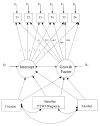Changes in PTSD symptomatology during acute and protracted alcohol and cocaine abstinence
- PMID: 17008029
- PMCID: PMC3712622
- DOI: 10.1016/j.drugalcdep.2006.08.025
Changes in PTSD symptomatology during acute and protracted alcohol and cocaine abstinence
Abstract
Previous research with substance users has demonstrated, across a variety of psychiatric disorders, significant decreases in psychological symptoms during early substance abstinence. To build on this literature, the current study prospectively assessed trauma symptomatology over 28 days during acute and protracted cocaine and alcohol abstinence. Participants were 162 male and female cocaine and/or alcohol dependent outpatients who reported a history of trauma. Trauma-related symptoms and substance use were assessed at 2, 5, 10, 14, 21, and 28 days following last substance use. For participants who were known to relapse, assessments began again after the last day of substance use. Latent growth modeling was employed to estimate changes in posttraumatic stress disorder (PTSD) symptoms. Consistent with studies of other psychiatric syndromes, PTSD symptoms declined across the 28-day study period regardless of withdrawal substance (i.e., cocaine or alcohol). The majority of change in trauma symptoms occurred within 2 weeks of last substance use. Moreover, while trauma symptoms for the PTSD participants were more severe than those reported by the non-PTSD participants, trauma symptoms declined across the study period at the same rate irrespective of PTSD status.
Figures


Similar articles
-
Cocaine-related attentional bias following trauma cue exposure among cocaine dependent in-patients with and without post-traumatic stress disorder.Addiction. 2011 Oct;106(10):1810-8. doi: 10.1111/j.1360-0443.2011.03508.x. Epub 2011 Jul 27. Addiction. 2011. PMID: 21615582 Free PMC article.
-
Acute and protracted cocaine abstinence in an outpatient population: a prospective study of mood, sleep and withdrawal symptoms.Drug Alcohol Depend. 2000 Jun 1;59(3):277-86. doi: 10.1016/s0376-8716(99)00126-x. Drug Alcohol Depend. 2000. PMID: 10812287
-
Trauma and substance cue reactivity in individuals with comorbid posttraumatic stress disorder and cocaine or alcohol dependence.Drug Alcohol Depend. 2002 Jan 1;65(2):115-27. doi: 10.1016/s0376-8716(01)00157-0. Drug Alcohol Depend. 2002. PMID: 11772473
-
[Posttraumatic stress disorder (PTSD) as a consequence of the interaction between an individual genetic susceptibility, a traumatogenic event and a social context].Encephale. 2012 Oct;38(5):373-80. doi: 10.1016/j.encep.2011.12.003. Epub 2012 Jan 24. Encephale. 2012. PMID: 23062450 Review. French.
-
Comorbidity of psychiatric disorders and posttraumatic stress disorder.J Clin Psychiatry. 2000;61 Suppl 7:22-32. J Clin Psychiatry. 2000. PMID: 10795606 Review.
Cited by
-
A Qualitative Study to Explore Feasibility of Implementing Seeking Safety and Trauma-Sensitive Yoga.Subst Use. 2025 Jun 24;19:29768357251350869. doi: 10.1177/29768357251350869. eCollection 2025 Jan-Dec. Subst Use. 2025. PMID: 40567553 Free PMC article.
-
Alcohol Abstainer Status and Prazosin Treatment in Association with Changes in Posttraumatic Stress Disorder Symptoms in Veterans with Comorbid Alcohol Use Disorder and Posttraumatic Stress Disorder.Alcohol Clin Exp Res. 2019 Apr;43(4):741-746. doi: 10.1111/acer.13969. Epub 2019 Feb 19. Alcohol Clin Exp Res. 2019. PMID: 30698839 Free PMC article. Clinical Trial.
-
PTSD symptoms and alcohol-related problems among veterans: Temporal associations and vulnerability.J Abnorm Psychol. 2018 Nov;127(8):733-750. doi: 10.1037/abn0000376. Epub 2018 Oct 4. J Abnorm Psychol. 2018. PMID: 30284858 Free PMC article.
-
Trauma-focused exposure therapy for chronic posttraumatic stress disorder in alcohol and drug dependent patients: A randomized controlled trial.Psychol Addict Behav. 2016 Nov;30(7):778-790. doi: 10.1037/adb0000201. Epub 2016 Oct 27. Psychol Addict Behav. 2016. PMID: 27786516 Free PMC article. Clinical Trial.
-
Further Investigation of the Association between Anxiety Sensitivity and Posttraumatic Stress Disorder: Examining the Influence of Emotional Avoidance.J Contextual Behav Sci. 2015 Jul;4(3):163-169. doi: 10.1016/j.jcbs.2015.05.002. J Contextual Behav Sci. 2015. PMID: 27617195 Free PMC article.
References
-
- Alterman AI, McDermott PA, Brown LS, Jr, Cook TG, Metzger D, Rutherford MJ, Cacciola JS. New scales to assess change in the Addiction Severity Index for the opioid, cocaine, and alcohol dependent. Psychol Addict Behav. 1998;12:233–246.
-
- American Psychiatric Association. Diagnostic and Statistical Manual of Mental Disorders. 3. American Psychiatric Association; Washington, DC: 1987.
-
- Anderson E. AMOS FAQ #4: Fitting a latent growth curve model. 2004. Retrieved on June 10, 2005 from the University of Texas Information Technology Services Research Consulting Web site: http://www.utexas.edu/its/rc/answers/amos/amos4.html.
-
- Appleby L, Dyson V, Altman E, Luchins DJ. Assessing substance use in multiproblem patients: reliability and validity of the Addiction Severity Index in a mental hospital population. J Nerv Ment Dis. 1997;185:159–165. - PubMed
-
- Arbuckle JL. AMOS Users’ Guide Version 5.0.1. SmallWaters; Chicago: 2003.
Publication types
MeSH terms
Grants and funding
LinkOut - more resources
Full Text Sources
Medical

